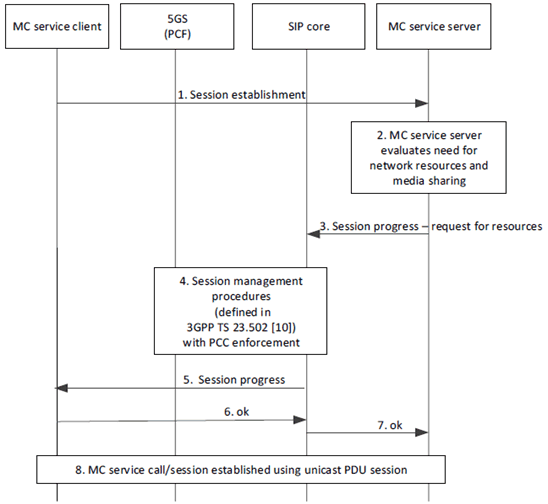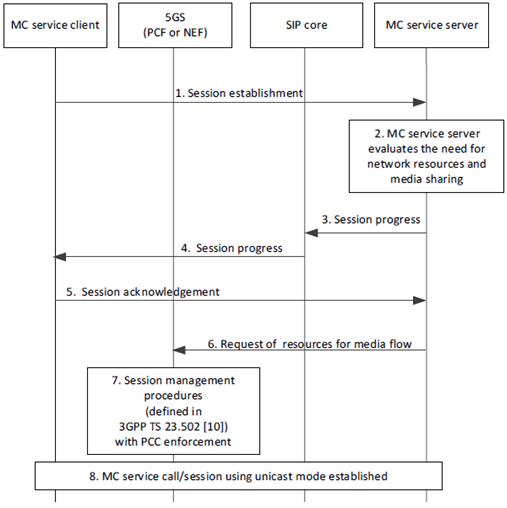Content for TS 23.289 Word version: 19.0.0
0…
4…
4.7…
4.7.4…
4.8…
5…
5.4…
6…
6.3…
6.3.2…
7…
7.2.4…
7.3…
7.3.3…
7.3.3.2…
7.3.3.4…
7.3.3.5…
7.3.3.7…
7.3.3.8…
7.3.3.9…
7.3.3.10…
7.3.3.11…
7.3.3.12…
7.3.3.13…
7.4…
7.5…
7.6…
A…
7 MC procedures for 5GS
7.1 General
7.2 MC service resource management (on-network)
7.2.1 General
7.2.2 Request for unicast resources at session establishment - SIP core based
7.2.3 Request for unicast resources at session establishment - MC service server based
...
...
7 MC procedures for 5GS p. 43
7.1 General p. 43
In this clause, only the procedures and information flows which are different from that over EPS are captured. The MC service specific procedures and information flows over 5GS remains the same as specified in TS 23.379, TS 23.281, TS 23.282 if not specially described in this clause.
7.2 MC service resource management (on-network) p. 44
7.2.1 General p. 44
These clauses specify the procedures for resource management for mission critical services. The procedures are utilized by the following MC services:
- MCPTT (as specified in TS 23.379);
- MCVideo (as specified in TS 23.281); and
- MCData (as specified in TS 23.282).
7.2.2 Request for unicast resources at session establishment - SIP core based p. 44
The procedure defined in this clause specifies how communication resources are requested from 5GS at session establishment. If concurrent sessions are used the MC service server may utilize the capability of resource sharing specified in TS 23.503. The exchange of the QoS characteristics of the required resources takes place exclusively by means of direct interaction between SIP core and PCF using N5 reference point or Rx reference point and encompass media type, bandwidth, priority, application identifier and resource sharing information.
Establishment, modification or release of communication resources are managed according to TS 23.503. The procedure is generic to any type of session establishment that requires communication resources.
Procedures in Figure 7.2.2-1 show the signalling procedures for the requesting resource at session establishment.

Figure 7.2.2-1: Resource request at session establishment - SIP core based
(⇒ copy of original 3GPP image)
(⇒ copy of original 3GPP image)
Step 1.
MC service client sends a session establishment request.
Step 2.
MC service server receives evaluates the need of communication resources and the use of media resource sharing.
Step 3.
MC service server sends a session progress request containing request for communication resources.
Step 4.
Session management procedures using PCF policy control enforcement (as defined in TS 23.503) initiated from SIP core local inbound/outbound proxy using direct interaction between SIP core and PCF.
Step 5.
The SIP core local inbound/outbound proxy forwards the call control protocol request to the MC service client.
Step 6.
The MC service client acknowledges the session progress request with an OK message.
Step 7.
The SIP core local inbound/outbound proxy forwards the OK message to the MC service server.
Step 8.
The MC service session is established, and resources have been allocated.
7.2.3 Request for unicast resources at session establishment - MC service server based p. 45
7.2.3.1 General p. 45
The procedure defined in this clause specifies how communication resources are requested from 5GS at session establishment from the MC service server. The required QoS characteristics for resources are sent directly to the PCF via the N5 reference point or Rx reference point from the MC service server. Alternatively, QoS characteristics for resources can be exchanged indirectly utilizing N33 reference point between MC service server and NEF. QoS characteristic information encompasses media type, bandwidth, priority, application identifier, resource sharing information and network slice information. If concurrent sessions are used, the MC service server may utilize the capability of resource sharing specified in TS 23.503.
For the request of communication resources by the MC service server via N5 reference point or Rx reference point, or N33 reference point, the MC service client provides to the MC service server the corresponding communication resource details (e.g. IP addresses and ports) of the MC service client and the corresponding media anchoring points.
This procedure is generic to any type of session establishment with the MC service server requesting network resources.
7.2.3.2 Procedure p. 46
Figure 7.2.3.2-1 describes the procedure for the request of resources at session establishment from the MC service server.

Figure 7.2.3.2-1: Resource request at session establishment - MC service server based
(⇒ copy of original 3GPP image)
(⇒ copy of original 3GPP image)
Step 1.
The MC service client sends a session establishment request. The request includes, apart from the SDP offer, access resource details, e.g. IP addresses and ports of the MC service client related to the media session.
Step 2.
The MC service server evaluates the need of communication resources and use of media resource sharing.
Step 3.
The MC service server sends a session progress request to the SIP core.
Step 4.
The SIP core local inbound/outbound proxy forwards the session progress request to the MC service client.
Step 5.
The MC service client acknowledges the session establishment to the MC service server. This message contains the final negotiated media parameters, e.g. IP addresses and ports related to the media anchoring points received in the SDP answer from the SIP core.
Step 6.
To trigger resources allocation, the MC service server sends a request for media resources to 5GS. For direct interaction, the resource allocation request is exchanged between MC service server and 5GS PCF using N5 reference point or Rx reference point. For indirect interaction, the resource allocation request is exchanged between MC service server and 5GS NEF using N33 reference point. The respective procedures are defined in TS 23.503).
Step 7.
Session management procedures using PCF policy control enforcement (as defined in TS 23.503) initiated from MC service server either directly via PCF or indirectly via NEF.
Step 8.
The MC service session is established, and resources have been allocated.